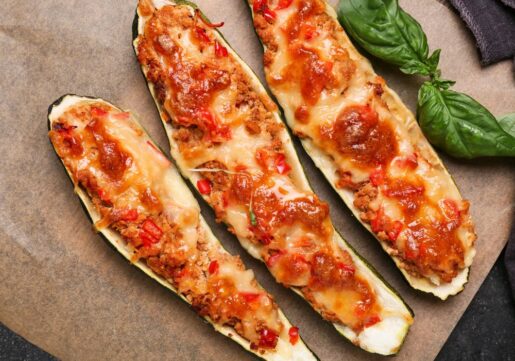
Serves: 4
Ingredients:
Crust
- 180 g of unbleached all-purpose flour
- 60 g of white whole wheat flour
- 3/4 teaspoon salt
- 1/2 teaspoon instant yeast or active dry yeast
- 3/4 cup (170g) lukewarm water
- 1 tablespoon (13g) olive oil + 1 1/2 tablespoons (18g) olive oil for the pan
Toppings:
- 6 ounces (170g) mozzarella, grated (about 1 1/4 cups, loosely packed)
- 1 1/2 cups pizza sauce
- freshly grated hard cheese (such as parmesan or pecorino) and fresh basil for sprinkling on top after baking
Directions:
- Place the flour, salt, yeast, water, and 1 tablespoon (13g) of the olive oil in a medium mixing bowl.
- Stir everything together to make a shaggy, sticky mass of dough with no dry patches of flour. This should take about 1 minute by hand, using a spoon or spatula. Scrape down the sides of the bowl to gather the dough into a rough ball; cover the bowl.
-
After 5 minutes, uncover the bowl and reach a bowl scraper or your wet hand down between the side of the bowl and the dough, as though you were going to lift the dough out. Instead of lifting, stretch the bottom of the dough up and over its top. Repeat three more times, turning the bowl 90° each time. This process of four stretches, which takes the place of kneading, is called a fold (see example).
-
Re-cover the bowl, and after 5 minutes do another fold. Wait 5 minutes and repeat; then another 5 minutes, and do a fourth and final fold. Cover the bowl and let the dough rest, undisturbed, for 40 minutes. Then refrigerate it for a minimum of 12 hours, or up to 72 hours. It’ll rise slowly as it chills, developing flavor; this long rise will also add flexibility to your schedule.
-
About 3 hours before you want to serve your pizza, prepare your pan. Pour 1 1/2 tablespoons (18g) olive oil into a well-seasoned 10 or 12″ cast iron skillet. Heavy, dark cast iron will give you a superb crust. Tilt the pan to spread the oil across the bottom, and use a paper towel to spread some oil around the pan and up the edges.
-
Transfer the dough to the pan and turn it once to coat both sides with the oil. After coating the dough in oil, press the dough to the edges of the pan, dimpling it using the tips of your fingers in the process. The dough may start to resist and shrink back; that’s OK, just cover it and let it rest for about 15 minutes, then repeat the dimpling/pressing. At this point the dough should reach the edges of the pan; if it doesn’t, give it one more 15-minute rest before dimpling/pressing a third and final time.
- Cover the crust and let it rise for 2 hours at room temperature. The fully risen dough will look soft and pillowy and will jiggle when you gently shake the pan.
-
About 30 minutes before baking, place one rack at the bottom of the oven and one toward the top (about 4″ to 5″ from the top heating element). Preheat the oven (or Traeger) to 450°F.
-
When you’re ready to bake the pizza, sprinkle about three-quarters of the mozzarella (a scant 1 cup) evenly over the crust. Cover the entire crust, no bare dough showing; this will yield caramelized edges. Dollop small spoonfuls of the sauce all over the cheese (don’t skimp — the sauce adds a lot of the flavor); laying the cheese down first like this will prevent the sauce from seeping into the crust and making it soggy. Sprinkle on the remaining mozzarella and a little parmesan.
-
Bake the pizza on the bottom rack of the oven for 18 to 20 minutes, until the cheese is bubbling and the bottom and edges of the crust are a rich golden brown (use a spatula to check the bottom). If the bottom is brown but the top still seems pale, transfer the pizza to the top rack and bake for 2 to 4 minutes longer. On the other hand, if the top seems fine but the bottom’s not browned to your liking, leave the pizza on the bottom rack for another 2 to 4 minutes.
- Remove the pizza from the oven and place the pan on a heatproof surface. Carefully run a spatula between the edge of the pizza and side of the pan to prevent the cheese from sticking as it cools. Let the pizza cool very briefly; as soon as you feel comfortable doing so, carefully transfer it from the pan to a cutting surface. This will prevent the crust from becoming soggy.
- Cut into 4 servings. Serve the pizza with extra sauce on the side.
Variations & Notes:
-
Our base cheese of choice is a block of low-moisture mozzarella, coarsely grated. Want to experiment with different cheeses? Choose those that melt well: Fontina, cheddar, Jack, provolone, Gouda, and Muenster are all good candidates.
-
Want to add your own favorite toppings beyond red sauce and cheese? Vegetables or meats should be cooked before arranging them in a single layer atop cheese and sauce. Feel free to experiment with other sauces, too; pesto or white sauce are great alternatives to tomato. One hint: To avoid potential sogginess, stick to the same quantities and layering process for sauce and cheese listed above.
-
For an extra hit of flavor, sprinkle freshly grated hard cheese (e.g., Parmesan, Asiago, Romano) and/or fresh herbs (oregano, basil, thyme) over the hot pizza just before serving.
-
If you’re serving the entire pizza (no leftovers) right away, you can serve it right from the pan if desired. We don’t recommend using a knife to cut the pizza in the pan; it might mar your cast iron’s surface. Instead, after loosening the edges, use a spatula to partially lift the pizza out of the pan, then cut a wedge using a pair of standard household scissors or kitchen shears. Remove the wedge and repeat until you’ve cut and served all of the pizza.
-
Feeding a larger group? Double all the ingredients in the recipe and follow the recipe instructions as written, dividing the dough into two pans (mix and match from the choices listed in step #6 above).
If You Loved This Recipe, You Might Also Enjoy ...
Did You Make This Recipe?
Please let me know how it turned out for you! Leave a comment below...
You must be logged in to post a comment.



